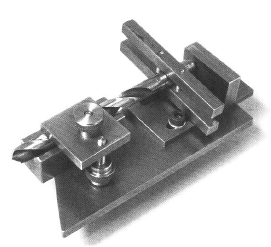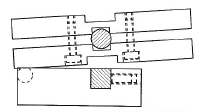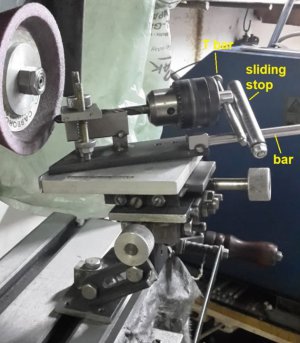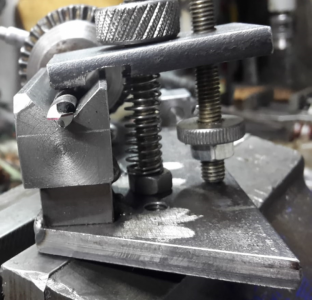Some of you may be familiar with Howard Hall’s drill grinding jig used in conjunction with his “advanced grinding rest”. After fabricating both and becoming quite familiar with the designs and their use, the only component that was a pain to use was the “180° rotation device”.
 Workshop Practice Series 38_Tool and Cutter Sharpening_Hall
Workshop Practice Series 38_Tool and Cutter Sharpening_Hall
Hall’s device consists of 2 square bars with a slot in the middle that hold the drill and allow you to flip the drill over in the jig to grind either cutting edges.
 Workshop Practice Series 38_Tool and Cutter Sharpening_Hall
Workshop Practice Series 38_Tool and Cutter Sharpening_Hall
One needs to be careful that the square bars are parallel to each other, otherwise the grind will be different. Hall says that one should not fuss over this. In practice any misalignment will cause a drill to cut oversize. Additionally, a broken drill may need to be rotated after initial grinding, having to loosen, retighten and confirming the parallelism of these darn bars.
I started thinking on an improvement on this 180° rotation device. Basically, its job is to hold various diameters in a position in relation to a stop. Since we are in theme, why not use a drill chuck fitted with a T bar. A bar was added for the T bar to rest on. The drill end stop slides on this bar.
Now, having eliminated all the fiddling with the rotation device, drill grinding is a breeze. Procedure is the same. A drill is placed in the V, aligned and locked. The chuck jaws are closed on the drill and tightened when the T bar is resting on the bar. The sliding stop is finally brought into contact with the back of the chuck.


I can easily do four facet drill grinding and my drills are a sliding fit in the holes they produce.
 Workshop Practice Series 38_Tool and Cutter Sharpening_Hall
Workshop Practice Series 38_Tool and Cutter Sharpening_HallHall’s device consists of 2 square bars with a slot in the middle that hold the drill and allow you to flip the drill over in the jig to grind either cutting edges.
 Workshop Practice Series 38_Tool and Cutter Sharpening_Hall
Workshop Practice Series 38_Tool and Cutter Sharpening_HallOne needs to be careful that the square bars are parallel to each other, otherwise the grind will be different. Hall says that one should not fuss over this. In practice any misalignment will cause a drill to cut oversize. Additionally, a broken drill may need to be rotated after initial grinding, having to loosen, retighten and confirming the parallelism of these darn bars.
I started thinking on an improvement on this 180° rotation device. Basically, its job is to hold various diameters in a position in relation to a stop. Since we are in theme, why not use a drill chuck fitted with a T bar. A bar was added for the T bar to rest on. The drill end stop slides on this bar.
Now, having eliminated all the fiddling with the rotation device, drill grinding is a breeze. Procedure is the same. A drill is placed in the V, aligned and locked. The chuck jaws are closed on the drill and tightened when the T bar is resting on the bar. The sliding stop is finally brought into contact with the back of the chuck.


I can easily do four facet drill grinding and my drills are a sliding fit in the holes they produce.

